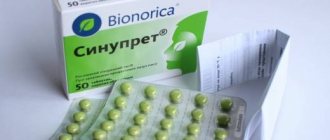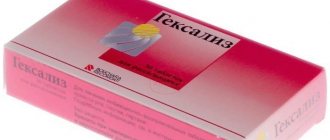The combined antibacterial agent is Grammidin. Instructions for use will show how to properly take lozenges, Neo, including with an antibiotic and anesthetic for the treatment of sore throat.
Grammidin for children and neo
Grammidin is an antibacterial agent for topical use, for resorption in the oral cavity. The active substance exhibits a bactericidal effect by increasing the permeability of the cell wall of bacteria (both gram-positive and gram-negative). What does Grammidin help with?
Composition and release form
Grammidin is produced in the form of lozenges containing the active substance (gramicidin C) in the amount of 1.5 g and auxiliary components: sugar, lactose, methylcellulose and calcium stearate.
A number of analogues of the drug are also produced (in the form of cheek tablets):
- Grammidin NEO containing 3 mg gramicidin C and 1 mg cetylpyridinium chloride;
- Grammidin for children containing 1.5 mg of gramicidin C and 1 mg of cetylpyridinium chloride;
- Grammidin with anesthetic containing 1.5 mg gramicidin C and 10 mg lidocaine;
- Grammidin with anesthetic NEO containing: 3 mg gramicidin C, 0.2 mg oxybuprocaine hydrochloride and 1 mg cetylpyridinium chloride.
If there is hypersensitivity to the active component, the doctor may prescribe an analogue of the medication that has a similar mechanism of action - Bioparox aerosol.
Contraindications and possible side effects
As a rule, there are no contraindications to the use of this drug. Almost all children can take grammidin tablets. The impact is immediate and the child’s body quickly recovers. However, there are a number of conditions for which a doctor may refrain from prescribing medication. These baby conditions include:
- possible intolerance to the components contained in the drug (if the tablets are not accepted at the slightest level, stop taking them and replace them with another drug that does not contain side substances);
- if the baby is diagnosed with phenylketonuria;
- if open wounds are found in the child’s mouth.
They try not to prescribe Grammidin to patients under 4 years of age, since the tablet form of administration is not entirely comfortable and safe for them. During breastfeeding, this drug should also not be given to a small creature, even in dissolved form, since the active substances can negatively affect a fragile organism.
The drug has few side effects, however, their presence does occur. The most common, although less dangerous, is an allergic reaction to substances contained in the drug. The child may develop a rash, allergies, hives, and severe itching. Such a reaction may not end well; anaphylactic shock, fever may occur, lips and face may swell, and Quincke's edema may occur.
We recommend: Motilium for children
Already these consequences can be called quite severe and serious. Their occurrence can even pose a danger to the baby’s life. Therefore, before using Grammidin, you need to carefully study the instructions and exclude the possibility of allergic reactions in your child to one or another component of the medicine.
An overdose of medication can cause a number of negative reactions in the body in a small child. He may experience diarrhea, nausea and vomiting.
Medical instructions for use
The tablets should be dissolved in the mouth until completely dissolved, periodically swallowing the saliva released in large quantities. It is optimal to dissolve the tablets after meals, since after taking Grammidin it is recommended to abstain from drinking and eating for 1 to 2 hours.
The recommendation not to consume food or drinks for 1 to 2 hours after resorption of the Grammidin tablet is due to the fact that for the best therapeutic effect, the active substances should remain on the mucous membranes for as long as possible, and drinking and food will simply wash them away, thereby stopping their effect.
Grammidin can be used for children from 4 years of age and adults. In this case, children aged 4–12 years should dissolve 1–2 tablets 4 times a day, and adolescents over 12 years of age and adults should take 2 tablets 4 times a day. The maximum permissible daily dosage is 8 tablets.
The two tablets should be dissolved one after the other, and not simultaneously. That is, first a person must dissolve one tablet, and only after that put the second one into the oral cavity. You should not place two tablets in your mouth and dissolve at the same time, as this will lead to a less uniform distribution of the active substance throughout the mucous membranes of the mouth and throat and, accordingly, lower therapeutic effectiveness of the drug.
The duration of use of Grammidin is 5–6 days. If within a week the use of Grammidin does not bring relief, then you should stop taking the drug and consult a doctor.
How to take Grammidin for children:
- 4-12 years - 1 pc. 4 times a day.
- Teenagers - 2 lozenges 4 times a day.
Neo and Neo+anesthetic:
- Child 4-12 years old - The instructions indicate the use of 1 pc. 1-2 times a day.
- Adults - 1 capsule 3-4 times a day for no longer than a week in a row.
Grammidin - instructions for using the drug for the throat with an anesthetic:
- Child 3-12 years old. According to the instructions, it is recommended to use 1-2 pcs. 4 times a day.
- Adults. 2 lozenges four times a day. The general course is no more than a week for any age.
Grammidin Neo with anesthetic
Infectious and inflammatory diseases of the mouth and throat: sore throat, pharyngitis, tonsillitis, periodontal disease, gingivitis, stomatitis.
In a place protected from light, at a temperature not exceeding 25 °C.
https://www.youtube.com/watch?v=upload
Keep out of the reach of children.
2 years.
Do not use after the expiration date stated on the package.
- Lozenges
Grammidin with anesthetic is a medicine for severe sore throat, because it contains a local anesthetic - oxybuprocaine. Many patients are interested in: “Which Grammidin is stronger?” Differences in the line of drugs concern only the severity of the analgesic effect. In Grammidin with an anesthetic it is maximum, while the product retains the adult dosage of the antibiotic Gramicidin C (3.20 mg) and the antiseptic cetylpyridinium chloride (1.05 mg).
Grammidin with an anesthetic is perhaps the best drug for severe sore throat. The anesthetic oxybuprocaine quickly and reliably blocks sensitive nerve endings, so painful sensations in the throat will not bother you for a long time. At the same time, Grammidin with an anesthetic also has an antimicrobial effect, affecting the immediate cause of throat diseases.
Grammidin Neo with anesthetic is available in lozenges.
Adults and children over 12 years of age are recommended to take the drug 1 tablet 3-4 times a day.
For children from 4 to 12 years old, the frequency of administration should be reduced to 1-2 times a day, but also take 1 tablet.
This product is produced in the form of lozenges. The main components of the drug are gramicidin C hydrochloride and cetylpyridinium chloride monohydrate.
Additional Ingredients:
- magnesium stearate;
- sorbitol;
- colloidal silicon dioxide;
- talc;
- acesulfame potassium;
- aromatic filler.
The medicine is packaged in blisters with contour cells of 9 pcs. The cardboard package contains 2 blisters.
Is Grammidin an antibiotic or not?
Yes, it's an antibiotic. The main active ingredient is gramicidin C, an antibacterial agent for topical use, discovered back in the forties of the last century. The compound produced by the bacteria Bacillus brevis has been refined over several decades and has finally found application - local antibiotic therapy for respiratory infections (oral lozenges).
Read also: What is Ampicillin for? Instructions for use (500 mg and 250 mg tablets, suspension and injections)
Gramicidin is active against a wide range of pathogenic microbes: staphylococci, streptococci, some anaerobes. The main area of its bactericidal activity is gram-positive microorganisms, and they do not develop resistance to this antimicrobial drug at all. It acts bactericidal by increasing the permeability of the cell cytoplasmic membrane.
Description[ | ]
In industry it is obtained synthetically [ source not specified 470 days
].
It has a bacteriostatic (preventing the proliferation of bacteria) and bactericidal (destroying bacteria) effect[1].
Effective against streptococci and staphylococci, as well as pathogens of anaerobic infections and other microorganisms, mainly active against gram-positive bacteria [1]. Microorganisms practically do not develop resistance to this antibiotic[2].
It is used in the treatment of purulent and inflammatory infections of the skin and soft tissues, ulcers, bedsores, and for diseases such as inflammatory diseases of the ear, throat, stomatitis, gingivitis, conjunctivitis, keratitis, osteomyelitis (inflammation of the bone marrow and adjacent bone tissue), blepharitis, phlegmon , furunculosis, carbuncles. It is used for skin burns and also as a local contraceptive[1].
Release form: solution or paste (in tubes or jars) for topical use. Available in the form of 5 ml ampoules of a 2% sterile alcohol solution, cheek tablets [ source not specified 470 days
].
Enhances the effects of other bactericidal agents [ source not specified 470 days
].
Intended for topical use only. Intravenous use is not allowed[1].
It has side effects - allergic reactions (skin rashes and itching, fever, urticaria, swelling, contact dermatitis, anaphylactic shock). Use during pregnancy and lactation is undesirable [ source not specified 470 days
].
Analogs
- Abisil;
- Azivok;
- Azitral;
- Aqualor;
- Aldolor;
- Alphacet;
- Ambien;
- Amoxisar;
- Amoxicillin;
- Ampicillin;
- Angin Khel SD;
- Anti Angin Formula;
- Arlet;
- Augmentin;
- Afenoxin;
- Bactrim;
- Bicarmint;
- Biodroxyl;
- Bioparox;
- Biseptol;
- Bicillin;
- Vepicombin;
- Vibramycin;
- Vilprafen;
- Vilprafen solutab;
- Voqara;
- Hexadreps;
- Hexalize;
- Hexapneumin;
- Hexaspray;
- Hexoral;
- Hexoral tabs;
- Hyposol;
- Grunamox;
- Children's Panadol;
- Dinabak;
- Doxilan;
- Doxycycline hydrochloride;
- Dr. Theiss;
- Zanotsin;
- Zetsil;
- Zinnat;
- Zitrolide forte;
- IRS 19;
- Iodinol;
- Yox;
- Quipro;
- Ketoceph;
- Clamosar;
- Clarithromycin;
- Cliacyl;
- Laripront;
- Lidaprim;
- Liproquin;
- Methyluracil;
- Methovit;
- Microflox;
- Miramistin;
- Nalgesin;
- Natsef;
- Neo sore throat;
- Novosept Forte;
- Sea buckthorn oil;
- Oxamp;
- Orelox;
- Ospexin;
- Ospen;
- Palitrex;
- Panadol Extra;
- Perti;
- Povidone iodine;
- Polyoxidonium;
- Propolis tincture;
- Ribomunil;
- Rovamycin;
- Rulid;
- Sangviritrin;
- Sextaphage;
- Septolete;
- Syphlox;
- Solpadeine;
- Stopangin;
- Strepsils;
- Streptocide tablets;
- Sultasin;
- Sumasid;
- Sumamed;
- Sumamed forte;
- Sumetrolim;
- Super;
- Suprax;
- Tantum Verde;
- Taromentin;
- TeraFlu Lar;
- Terzef;
- Timentin;
- Tomicide;
- Tonsilgon N;
- Tonsilotren;
- Falimint;
- Faringopils;
- Faringosept;
- Felexin;
- Fervex for sore throat;
- Flemoklav Solutab;
- Fromilid;
- Furacilin;
- Chemomycin;
- Tsedex;
- Cephabol;
- Cefazolin;
- Cephalexin;
- Cefat;
- Cefatrexil;
- Cefezol;
- Cefosin;
- Cefotaxime;
- Cefspan;
- Ceftriabole;
- Cefurabol;
- Zeff;
- Ciprobid;
- Cyprobrine;
- Tsiprolet A;
- Tsiprosan;
- Ciprofloxacin;
- Tsifran;
- Ecositrin;
- Erythromycin;
- Unidox Solutab.
When choosing analogues, you must remember that the instructions for use of Grammidin, the price and reviews of drugs of similar effect do not apply. Replacing the drug is permissible only after the recommendation of a doctor.
pharmachologic effect
A combined drug for the treatment of infectious and inflammatory diseases of the pharynx and oral cavity. The drug contains the antimicrobial agent gramicidin C and the antiseptic agent cetylpyridinium chloride.
The mechanism of action of gramicidin C is associated with an increase in the permeability of the cytoplasmic membrane of the microbial cell, which disrupts its stability and causes cell death.
Gramicidin C has a pronounced antimicrobial effect against pathogens of infectious diseases of the oral cavity and pharynx.
Cetylpyridinium chloride is an antiseptic. Suppresses the growth and reproduction of pathogens of infectious diseases of the oral cavity.
The drug reduces inflammation, has an antimicrobial effect, softens discomfort in the throat, facilitates swallowing, and when absorbed causes hypersalivation, which promotes mechanical cleansing of the oral cavity and pharynx from microorganisms.








